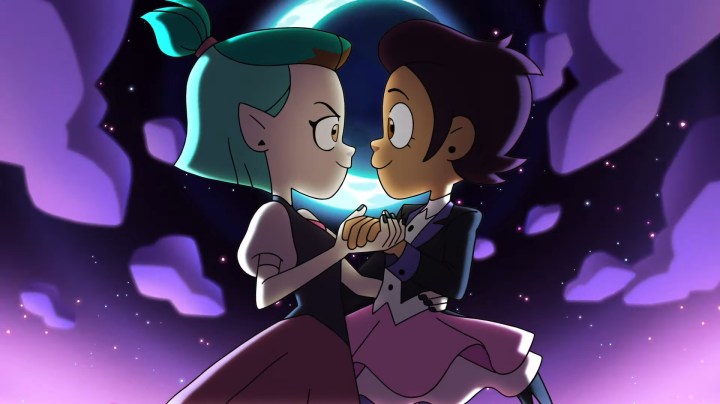Disney’s ‘The Owl House’ Is the Future of Intersectional Representation

Courtesy of Disney
When The Owl House first premiered on the Disney Channel in 2020, it became an instant hit with fans. The show follows Luz Noceda, a quirky and lively Latine girl as she gets transported into a magical world where she discovers she can fulfill her dreams of becoming a witch. At first glance, having a Latine protagonist on a Disney property isn’t a revolutionary feat. Disney’s Elena of Avalor and Pixar’s Coco come to mind as incredible examples of Latine-led stories under the Disney umbrella. But where Luz breaks all barriers, is by being Disney’s first, out and proud, bisexual lead character.
For the longest time, it’s felt as though leads in children’s animation could only be one thing on the diversity spectrum. You could either be a character of color (for example Anne Boonchuy from Amphibia, Jake Long from American Dragon: Jake Long), or a queer character (for example Adora from She-ra and the Princesses of Power, Kelsey Pokoly from Craig of the Creek), or a disabled character (Hiccup from How To Train Your Dragon, Felix Renton from Kim Possible) — but never more than one at the same time. It’s only recently that the intersectionalities of varying groups have been explored in animation.
Luz started the show representing weird, quirky, and outcast Latine kids everywhere. “When I was a kid, and I think a lot of kids feel like this — especially if you’re artsy or creative or have any kind of offbeat hobby — you feel a little left out. You feel a little detached from people and it might take you a little longer than most to find your crowd, your community,” Dana Terrace, the creator of The Owl House said in a Los Angeles Times article. But as the first season of the show progressed, it became clear that the team had bigger plans to push their desired representation further.
From the first season, the show confirmed Luz’s bisexuality after setting up her rival-turned-friend Amity as the romantic interest. The creator also mentioned that since development, she’s been very clear in her intention “[…] to put queer kids in the main cast.” Terrace, as well as many others in animation, have had to stand strong in their conviction to tell the stories and showcase the diversity they want to highlight. Thankfully, Terrace’s stubbornness paid off as Luz became one of a few characters in animation to date that is not just a Latine person, but who is also a part of the LGBTQ+ community. Her unique intersectionality is what makes her stand out and through the specificity of the people she’s “meant” to represent, is where she does the most good for our communities.

It’s important to understand that diversity isn’t one-sided, but rather exists in many forms and only becomes more specific in its intersections with each other. Luz is a perfect example of a character that’s both a person of color and part of the LGBTQ+ community. Ultimately, creating and championing characters whose representation is specific should never be seen as a bad thing because it’s through these specificities that universal stories flourish and viewers feel seen.